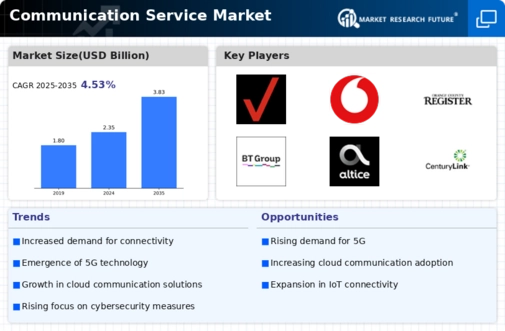Market Trends and Growth Projections
The Global Communication Service Market Industry is characterized by a dynamic landscape, with various trends influencing its trajectory. Current projections indicate a market value of 2.35 USD Billion in 2024, with expectations to reach 3.83 USD Billion by 2035. The anticipated CAGR of 4.53% from 2025 to 2035 highlights the industry's growth potential. Key trends include the rise of digital communication, advancements in technology, and an increasing focus on customer experience. These factors collectively shape the market's future, suggesting a robust and evolving communication service sector.
Increased Focus on Customer Experience
The Global Communication Service Market Industry is increasingly characterized by a focus on enhancing customer experience. Organizations are recognizing the importance of effective communication in building customer loyalty and satisfaction. As a result, they are investing in personalized communication strategies and tools that cater to individual preferences. This trend is supported by data indicating that businesses prioritizing customer experience are likely to see a significant return on investment. The emphasis on customer-centric communication is expected to drive market growth, contributing to a projected CAGR of 4.53% from 2025 to 2035, reflecting the industry's commitment to meeting evolving consumer expectations.
Rising Demand for Digital Communication
The Global Communication Service Market Industry experiences a notable surge in demand for digital communication solutions. As businesses and consumers increasingly rely on digital platforms for interaction, the market is projected to reach 2.35 USD Billion in 2024. This growth is driven by the proliferation of smartphones and internet connectivity, which facilitate seamless communication across various channels. Companies are investing in advanced communication technologies to enhance customer engagement and operational efficiency. The shift towards remote work and virtual collaboration further amplifies this trend, indicating a robust future for digital communication services.
Growing Adoption of Cloud-Based Solutions
The shift towards cloud-based communication solutions is a significant driver in the Global Communication Service Market Industry. Organizations are increasingly adopting cloud technologies to enhance flexibility, scalability, and cost-effectiveness in their communication strategies. The ability to access communication tools from anywhere fosters collaboration and productivity among remote teams. This trend is further supported by the increasing demand for unified communication as a service (UCaaS) solutions, which streamline communication processes. As businesses continue to embrace cloud solutions, the market is poised for growth, with projections indicating a substantial increase in market value over the coming years.
Technological Advancements in Communication
Technological innovations play a pivotal role in shaping the Global Communication Service Market Industry. The advent of 5G technology is expected to revolutionize communication services by providing faster and more reliable connectivity. This advancement not only enhances user experience but also enables the development of new applications and services. As organizations adopt these technologies, the market is likely to witness substantial growth, with projections suggesting a rise to 3.83 USD Billion by 2035. The integration of artificial intelligence and machine learning into communication platforms further enhances service delivery, indicating a transformative phase for the industry.
Regulatory Support for Communication Infrastructure
Regulatory frameworks play a crucial role in shaping the Global Communication Service Market Industry. Governments worldwide are implementing policies to enhance communication infrastructure and promote digital inclusion. Initiatives aimed at expanding broadband access and improving connectivity in underserved areas are expected to drive market growth. By fostering an environment conducive to innovation and investment, regulatory support is likely to attract new players into the market. This proactive approach to communication infrastructure development suggests a promising outlook for the industry, as it aligns with global efforts to bridge the digital divide and enhance communication services.























